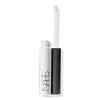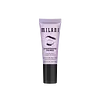What's inside
What's inside
 Key Ingredients
Key Ingredients

 Benefits
Benefits

No benefits
 Concerns
Concerns

 Ingredients Side-by-side
Ingredients Side-by-side

Isododecane
EmollientTalc
AbrasiveCyclopentasiloxane
EmollientDisteardimonium Hectorite
StabilisingVp/Eicosene Copolymer
Dimethicone
EmollientCetyl Ethylhexanoate
EmollientSorbitan Sesquioleate
EmulsifyingTrimethylsiloxysilicate
EmollientCaprylic/Capric Triglyceride
MaskingPropylene Carbonate
SolventPEG-40 Stearate
EmulsifyingSorbitan Olivate
EmulsifyingPhenoxyethanol
PreservativeTocopheryl Acetate
AntioxidantCera Alba
EmollientDiethylhexyl Syringylidenemalonate
Skin ProtectingOryza Sativa
Oryza Sativa Bran Extract
Skin ConditioningTriethoxycaprylylsilane
Castor Oil Phosphate
Emulsion StabilisingSea Whip Extract
Skin ConditioningMica
Cosmetic ColorantCI 77891
Cosmetic ColorantCI 77163
Cosmetic ColorantIsododecane, Talc, Cyclopentasiloxane, Disteardimonium Hectorite, Vp/Eicosene Copolymer, Dimethicone, Cetyl Ethylhexanoate, Sorbitan Sesquioleate, Trimethylsiloxysilicate, Caprylic/Capric Triglyceride, Propylene Carbonate, PEG-40 Stearate, Sorbitan Olivate, Phenoxyethanol, Tocopheryl Acetate, Cera Alba, Diethylhexyl Syringylidenemalonate, Oryza Sativa, Oryza Sativa Bran Extract, Triethoxycaprylylsilane, Castor Oil Phosphate, Sea Whip Extract, Mica, CI 77891, CI 77163
Isododecane
EmollientTalc
AbrasiveMica
Cosmetic ColorantCyclopentasiloxane
EmollientDisteardimonium Hectorite
StabilisingTrimethylsiloxysilicate
EmollientTrihydroxystearin
Skin ConditioningPolyethylene
AbrasiveTriethylhexanoin
MaskingSorbitan Sesquioleate
EmulsifyingVp/Eicosene Copolymer
Dimethicone
EmollientDipalmitoyl Hydroxyproline
Skin ConditioningPhenoxyethanol
PreservativePEG-40 Stearate
EmulsifyingSynthetic Beeswax
Emulsion StabilisingPropylene Carbonate
SolventEthylhexylglycerin
Skin ConditioningWater
Skin ConditioningCI 77891
Cosmetic ColorantCI 77163
Cosmetic ColorantIron Oxides
Isododecane, Talc, Mica, Cyclopentasiloxane, Disteardimonium Hectorite, Trimethylsiloxysilicate, Trihydroxystearin, Polyethylene, Triethylhexanoin, Sorbitan Sesquioleate, Vp/Eicosene Copolymer, Dimethicone, Dipalmitoyl Hydroxyproline, Phenoxyethanol, PEG-40 Stearate, Synthetic Beeswax, Propylene Carbonate, Ethylhexylglycerin, Water, CI 77891, CI 77163, Iron Oxides
Ingredients Explained
These ingredients are found in both products.
Ingredients higher up in an ingredient list are typically present in a larger amount.
This synthetic powder is used to add a pearly/white color in cosmetics.
Ci 77891 is a white pigment from Titanium dioxide. It is naturally found in minerals such as rutile and ilmenite.
It's main function is to add a white color to cosmetics. It can also be mixed with other colors to create different shades.
Ci 77891 is commonly found in sunscreens due to its ability to block UV rays.
Learn more about CI 77891Cyclopentasiloxane, or D5, is a silicone used to improve texture of products and trap moisture.
D5 is considered lightweight and volatile. Volatile means it evaporates quickly after application. Once evaporated, D5 leaves a thin barrier that helps keep skin hydrated.
It is also an emollient. Emollients help soften the skin and prevent water loss. Silicones create a silky texture in products. D5 helps other ingredients become more spreadable.
Studies show D5 is safe to use in skincare products. We recommend speaking with a skincare professional if you have concerns.
Learn more about CyclopentasiloxaneDimethicone is a type of synthetic silicone created from natural materials such as quartz.
What it does:
Dimethicone comes in different viscosities:
Depending on the viscosity, dimethicone has different properties.
Ingredients lists don't always show which type is used, so we recommend reaching out to the brand if you have questions about the viscosity.
This ingredient is unlikely to cause irritation because it does not get absorbed into skin. However, people with silicone allergies should be careful about using this ingredient.
Note: Dimethicone may contribute to pilling. This is because it is not oil or water soluble, so pilling may occur when layered with products. When mixed with heavy oils in a formula, the outcome is also quite greasy.
Learn more about DimethiconeDisteardimonium Hectorite comes from the clay mineral named hectorite. It is used to add thickness to a product.
It can also help stabilize a product by helping to disperse other ingredients.
Hectorite is a rare, white clay mineral.
Learn more about Disteardimonium HectoriteIsododecane is a fragrance, emollient, and solvent.
As an emollient, it helps your skin stay soft and hydrated. Emollients help trap moisture into your skin.
Isododecane's role as a solvent makes it a great texture enhancer. It spreads smoothly on skin and does not leave a sticky feeling behind. Isododecane also helps prevent color transfer in makeup products.
Isododecane is not absorbed into skin.
Learn more about IsododecaneMica is a naturally occurring mineral used to add shimmer and color in cosmetics. It can also help improve the texture of a product or give it an opaque, white/silver color.
Serecite is the name for very fine but ragged grains of mica.
This ingredient is often coated with metal oxides like titanium dioxide. Trace amounts of heavy metals may be found in mica, but these metals are not harmful in our personal products.
Mica has been used since prehistoric times throughout the world. Ancient Egyptian, Indian, Greek, Roman, Aztec, and Chinese civilizations have used mica.
Learn more about MicaPeg-40 Stearate is a waxy solid made up of polyethylene glycol and stearic acid. It is an emulsifier and cleanser. Emulsifiers help oils and water mix.
Stearic acid is a a fatty acid. Therefore, Peg-40 stearate may not be fungal-acne safe.
Phenoxyethanol is a preservative that has germicide, antimicrobial, and aromatic properties. Studies show that phenoxyethanol can prevent microbial growth. By itself, it has a scent that is similar to that of a rose.
It's often used in formulations along with Caprylyl Glycol to preserve the shelf life of products.
This ingredient is a solvent. It helps dissolve active ingredients and alter the texture of products.
Propylene Carbonate is commonly used in makeup and with clay, such as montmorillonite or bentonite.
Studies show this ingredient to be safe for cosmetics. When it is undiluted, it can cause skin irritation. (It is always diluted in skincare and makeup). This ingredient is water-soluble.
Propylene Carbonate is created from propylene glycol and carbonic acid.
Learn more about Propylene CarbonateSorbitan Sesquioleate is derived from sorbitol and oleic acid. It is an emulsifier and prevents ingredients from separating.
Specifically, this ingredient is a water-in-oil emulsifier, meaning it helps water dissolve into oil.
Some studies suggest this ingredient may cause irritation in some people. If you are unsure, it is best to patch test.
This ingredient may not be Malassezia folliculitis, or fungal-acne safe.
Learn more about Sorbitan SesquioleateTalc is a clay mineral. It helps absorb moisture and improve the texture of products. Like other types of clay, Talc can have a slight exfoliating effect on skin. Talc can be added to increase the volume of products.
Some Baby powders are made by combining talc with corn starch. The word "talc" comes from Latin and originates from Arabic. Talc is a mineral commonly found throughout the world.
If you have any concerns about using talc, we recommend checking out the FDA's official page.
Learn more about TalcThis silicone is an emollient. Emollients create a thin film on the skin to prevent moisture from escaping.
It is not soluble in water and helps increase water-resistance in products.
According to a manufacturer, it can blend seamlessly with silicone oils, such as Cyclopentasiloxane.
Learn more about TrimethylsiloxysilicateWe don't have a description for Vp/Eicosene Copolymer yet.